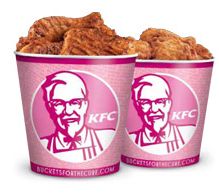 2010: Susan G. Komen for the Cure and Kentucky Fried Chicken start a cause marketing partnership. KFC sells buckets of chicken in special pink buckets and a portion of the sales is donated to Komen. The donation totalled $4.2 million – the single largest donation in Komen’s history.
2010: Susan G. Komen for the Cure and Kentucky Fried Chicken start a cause marketing partnership. KFC sells buckets of chicken in special pink buckets and a portion of the sales is donated to Komen. The donation totalled $4.2 million – the single largest donation in Komen’s history.
This is also one of the most controversial cause marketing partnerships in recent history. It came under heavy fire for promoting unhealthy eating habits that could contribute to obesity. While the criticism is warranted, how did cause marketing get to this point of “anything goes?”
Susan G. Komen for the Cure’s adventures in cause marketing have been coined as “pink washing.” From mittens to mixers to running shoes and more, Komen has 216 active cause marketing partnerships with companies who use the infamous pink ribbon to help raise awareness for breast cancer while selling their product. This progressive model has brought up a lot of ethics questions for charities in terms of who they align themselves with. But there are some questions that businesses should consider as well. Chief among them – is there a separation between generating profit and what is considered “doing good?”
To better understand this, let’s lay some ground work for what successful cause marketing partnerships.
Cause marketing is different than philanthropy. It is a marketing relationship that is mutually beneficial for the non-profit and the business. In some cases (like Komen and KFC) a tax-deductible donation will be made to the non-profit. Sometimes the marketing efforts are for awareness purposes. There is great power in combining the two brands. For a non-profit, the benefits can include increased financial support and increased visibility amongst potential donors via the company’s customer base. For the company, benefits can include positive public relations, increased revenue and additional marketing opportunities.
The genius of cause marketing lies within consumer psychology. When the business is selling a product that is not a “need” but a “want,” there is an extra step of rationalization that they consumer goes through – i.e. why is buying this a good idea? Looking at charitable cause marketing “want” products, the emotions that the purchase rationalization is that it is helping to do good is the world is key. In the case of many of the Komen cause marketing partnerships, consumers will associate their purchase as a sign that they are helping find a cure. For anyone with a relative or friend that has breast cancer, purchasing a pink item can make them feel as though they have power over the disease and that they are actively doing something to help their loved one.
Marketing in this space of extreme vulnerability becomes a grey area of ethics questions. Does it cross the line of unethical and exist as a self-serving activity for the business? You can argue both sides of this argument. The point is that cause marketing is not with out implications or repercussions for businesses. In today’s context where the media and consumers tend to be more critical of things like this, cause marketing campaigns can either be a great success or a big miss.
Successful partnerships must be carefully embarked on and measured effectively. A few factors that define the most successful cause marketing campaigns include:
– Thoroughly weighing the implications of the non-profit’s brand and your company’s brand – Will the combination of the brands help or hurt both parties.
– The product/service used for cause marketing makes sense in relation to the non-profit’s cause – i.e. It is not the pink bucket
– Cause marketing is part of a larger relationship your company plans to have/has with the non-profit – mutual interest is key for this endeavour and your business has a larger vision for doing great work with this non-profit.
– Both parties should create a list of needs and wants for the cause marketing campaign, which serves as the basis for campaign planning
– Maintain transparency with the public – nothing will sabotage a company’s reputation faster than a viral controversy. Make sure the PR team has their say in marketing plans.
Cause marketing offers businesses many benefits, but they are not without risks. Learn from the KFC bucket controversy and plan for a campaign that meaningfully engages your customers and the broader community.
Vanessa Chase is a non-profit consultant and owner of Vanessa Chase Associates where she works with clients on direct response campaigns and copy writing. She is also the editor of Philanthropy For All – a digital space designed for young people dedicated to collaboration, inspiration and action.




